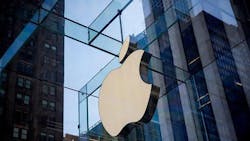Apple May Skirt IPhone Tariffs as Foxconn Comes to the US
Apple Inc. likes to say it supports two million U.S. jobs. Plans by the company’s main manufacturing partner for a $10 billion factory in Wisconsin will add at least 10,000 more, helping Apple fend off the threat of import tariffs on its most important product, the iPhone.
President Donald Trump and Foxconn Technology Group Chairman Terry Gou said in a White House press conference on July 26 that the factory will initially employ about 3,000 people, before expanding to as many as 13,000. It’s being built in House Speaker Paul Ryan’s home electoral district.
The factory will make LCD display panels for televisions and computer screens that are unlikely to carry the Apple logo. However, the investment may discourage lawmakers from introducing import taxes on products Foxconn does make for Apple, such as the iPhone, which are harder to assemble in the U.S.
“Foxconn is doing its best to try to head off a trade war and they’re obviously being quite strategic in terms of making their investment in house speaker Ryan’s home district and thereby trying to gain goodwill,” said Mark Wu, an assistant professor at Harvard Law School who serves on the World Economic Forum’s Global Future Council on Trade and Foreign Direct Investment. “If the administration did decide they wanted to target something, Foxconn could say ‘Go after someone else’s products rather than ours because we’re helping you’.”
Trump targeted Apple during his election campaign, promising to force the Cupertino, California-based company to bring more factory jobs to the U.S. The rhetoric prompted fears of a trade war with China, where contract manufacturers such as Foxconn, Pegatron Corp. and Quanta Computer Inc. assemble gadgets designed by U.S. tech companies.
“Currently Trump’s policy is to try to create job opportunities, so threatening import taxes was a way of encouraging companies to bring manufacturing to the U.S.,” said Annabelle Hsu, a researcher at IDC in Taiwan. “Now they’ve promised to do so, there’s less need to introduce such a tax.”
Making iPhones is more complex and labor-intensive than LCD panels, and smartphone assembly relies heavily on an extensive supply chain in China. That makes the prospect of import tariffs a real risk because Apple can’t easily ask contract manufacturers to put its phones together in the U.S. IHS Markit estimates that iPhone 7 manufacture costs $5 per handset in China, where labor costs are about 10 times cheaper than in the U.S.
Still, as much as $3 billion in state government incentives offered to lure Foxconn to the U.S. may ultimately bring other manufacturing facilities. The combination of lower shipping costs and incentives would more than offset higher American labor costs, according to IDC’s Hsu.
Apple plans to build three factories in the U.S., Trump told the Wall Street Journal in an interview on Tuesday. That move would mark a strategic change for Apple, which doesn’t have any major manufacturing facilities of its own. Foxconn is considering building a series of other plants that would use the LCD panels made in Wisconsin to make television and computer screens, a person familiar with the site-selection process told Bloomberg News. An Apple spokesman did not respond to a request for comment.
Since Trump won the election, Apple has pledged to invest $1 billion in advanced U.S. manufacturing. In May, it committed $200 million of those funds to Corning Inc., which supplies glass used in iPhone and iPad screens. Apple says it supports two million jobs in the U.S. through its suppliers and the App Store, and spent $50 billion with more than 9,000 U.S. suppliers in 2016.
Those numbers, coupled with the Foxconn investment, will help Apple Chief Executive Officer Tim Cook argue that his company is already making a significant contribution to U.S. jobs, according to Andrew Rose, an economics professor at the University of California, Berkeley’s Haas School of Business.
“We’re six months into the Trump presidency and not much has happened, and presumably that’s because the CEOs of these companies have some influence at the White House,” Rose said.
By Alex Webb
About the Author
Bloomberg
Licensed content from Bloomberg, copyright 2016.
